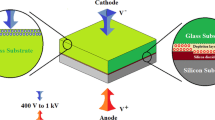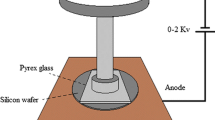Abstract
Hermeticity is one of the most critical issues for infrared (IR) sensor packages, since any leakage will impair the functionality of the device. The issues associated with the premature failure of hermetic sealants were studied in detail, both by simulation as well as by experimentation. Alternate prospective hermetic sealant candidates for transistor outline IR sensor packages were identified and evaluated. Hermetic sealant options for wafer-level IR sensor packaging were also investigated, which involves wafer-level hermetic cum vacuum packaging. Metallic hermetic sealant is preferred for this approach, since it facilitates integration with the getter material. However, the primary challenge encountered here is the requirement of high processing temperature for the getter activation. An activated getter adsorbs active gases inside the volume of the packages, resulting in lower internal pressure. It was determined that appropriate micro-alloying of the getter is required to minimize the getter activation temperature. This is achieved by selective micro-alloying of the getter material, which induces more grain boundaries and thereby promotes in-depth diffusion even at lower activation temperature. Integration of getter material with all three different types of metallic wafer-level bonding mechanisms was investigated. This includes eutectic, diffusion and transient liquid-phase bonding mechanisms. Selection of an appropriate bonding mechanism and integration scheme depends on the corresponding structure, layout and temperature rating of the specific IR sensor devices.
Similar content being viewed by others
References
L. Mauri, E. Rizzi, M. Moraja, and M. Campaneillo, in EMPC Conference Proceedings (2013), pp. 1–4.
D. Xu, E. Jing, B. Xiong, and Y. Wang, IEEE Trans. Adv. Packag. 33, 4 (2010).
Y. Chen and P. Li, in ICRMS Conference Proceedings (2011), pp. 482–485.
M. Boutchich, K. Ziouche, M.A.-H. Yala, and D. Leclercq, Sensor Actuator A Phys 121, 1 (2005).
V. Chidambaram, X. Ling, and C. Bangtao, J. Electron. Mater. 42, 3 (2013).
Ryan R.K. and Ronald G. Polcawich, in INERTIAL Conference Proceedings (2017), pp. 105–108.
R.M. Woo, K.Y. Au, Y. Jun, W.L. Ching, and F.X. Che, in EPTC Conference Proceedings (2014), pp. 16–21.
K.Y. Au, F.X. Che, and W.L. Ching, in ECTC Conference Proceedings (2017), pp. 1107–1112.
M. Wu, S. Lemettre, D. Mansour, M-P. Plante, A. Bosseboeuf, S. Seok, and I. Moulin, in DTIP Conference Proceedings (2017), pp. 1–4.
D. Yu, Microelectron. Reliab. 52, 3 (2012).
V. Chidambaram, J. Hald, and J. Hattel, J. Alloy Compd. 490, 1–2 (2010).
V. Chidambaram, C. Bangtao, G.C. Lip, and R.M. Woo, J. Electron. Mater. 43, 7 (2014).
L. Mauri, E. Rizzi, M. Moraja, and M. Campaniello, in EMPC Conference Proceedings (2013), pp. 1–4.
D.F. Lim, J. Fan, L. Peng, K.C. Leong, and C.S. Tan, J. Electron. Mater. 42, 3 (2013).
M. Abouie, Q. Liu, and D.-G. Ivey, Mater. Sci. Eng. B Solid 177, 20 (2012).
J. Froemel, M. Wiemer, and T. Gessner, J. Microelectromech. Syst. 24, 6 (2015).
J-M. Song, S-Y. Liang, P-H, Chiang, S-K. Huang, Y-T. Chiu, D. Tarng, C-P. Hung, and J-Y. Lin, in ICEP Conference Proceedings (2017), pp. 57–60.
J. Fan, D.F. Lim, L. Peng, K.H. Li, and C.S. Tan, Microsyst. Technol. (2013). https://doi.org/10.1007/s00542-012-1689-4.
CD. Don, L. Jae-Wung, C. Bangtao, and N. Singh, in EPTC Conference Proceedings (2017), pp. 1–4.
C. Geng Li, C. Bangtao, and N. Singh, in EPTC Conference Proceedings (2015), pp. 16–21.
V. Chidambaram and S. Wickramanayaka, J. Electron. Mater. 44, 7 (2015).
V. Dragoi, J. Eric Pabo, and G.Mittendorfer Burggaf, Microsyst. Technol. (2012). https://doi.org/10.1007/s00542-012-1439-7.
L. Zhang, Z.-Q. Liu, S.-W. Chen, Y.-D. Wang, W.-M. Long, Y.-H. Guo, S.-Q. Wang, G. Ye, and W.-Y. Liu, J. Alloy Compd. 750, 25 (2018).
B.-S. Lee, S.-K. Hyun, and J.-W. Yoon, Mater. Sci. Mater. Electron. (2017). https://doi.org/10.1007/s10854-017-6479-4.
Acknowledgments
This work is supported by the Agency for Science, Technology and Research (A*STAR) and Singapore Maritime Institute (SMI), Singapore, under the grant no. SMI-2015-OF-02.
Author information
Authors and Affiliations
Corresponding author
Additional information
Publisher's Note
Springer Nature remains neutral with regard to jurisdictional claims in published maps and institutional affiliations.
Rights and permissions
About this article
Cite this article
Chidambaram, V., Bu, L. & Chuan, K.L. Hermetic Sealant Material Possibilities for IR Sensor Packaging. J. Electron. Mater. 48, 6470–6479 (2019). https://doi.org/10.1007/s11664-019-07427-9
Received:
Accepted:
Published:
Issue Date:
DOI: https://doi.org/10.1007/s11664-019-07427-9




